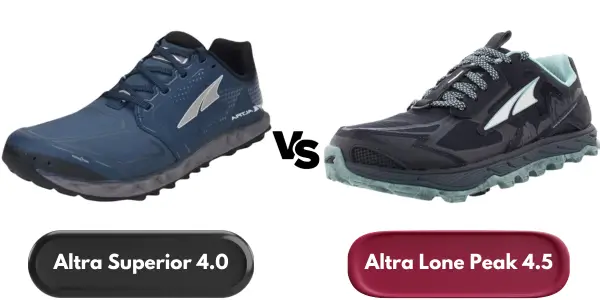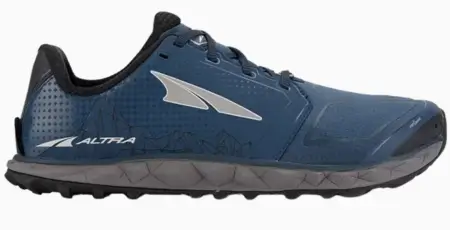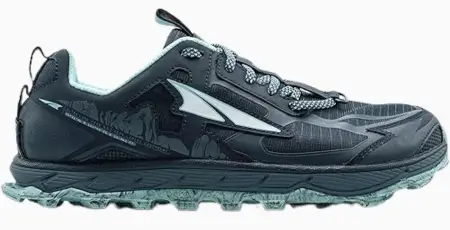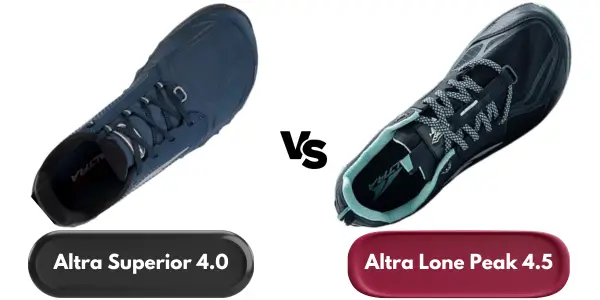Altra Superior vs Lone Peak
Last Updated: January 01, 2025 | Author: Jake Thompson
Imagine you're prepping for a challenging trail run that demands a shoe that can handle both the technical terrain and the long miles ahead. You're torn between the Altra Superior 4.0 with its lean, terrain-sensitive build, and the Lone Peak 4.5 known for its plush cushioning.
Both are stellar choices from the fastest-growing brand of Altra, offering its hallmark zero-drop shoe platform and foot-shaped toe box, but they cater to slightly different needs. You're seeking a stable shoe that won't just carry you through the rough patches, but one that'll be a true extension of your foot, adapting to every rock, root, and ridge.

As you weigh the importance of responsiveness against the comfort of cushioning, the decision between these two models becomes more than just a choice—it's about finding the right partner for your trail-running escapades, one that complements your stride and the nature of your excursions.
Stay tuned as we dissect the fine points of the Altra Superior vs Lone Peak to help you pinpoint the perfect fit for your next outdoor challenge.
For runners interested in exploring different terrains, our review of Brooks Ghost vs Revel provides insights into shoes designed for both road and trail running..
Table of Content:
- Key Takeaways
- Table: Altra Superior vs Lone Peak Key Differences
- Performance
- Comfort
- Cushioning
- Weight and Stack Height
- Traction and Terrain
- Durability and Protection
- Sizing and Fit
- Frequently Asked Questions
Key Takeaways
- - Altra Superior 4.0 is a more minimalist, performance shoe, while Altra Lone Peak 4.5 is a safer and versatile option that closely resembles a typical running shoe anatomy.
- - Altra Lone Peak offers more cushioning compared to Superior 4.0, providing better protection against sharp rocks and making it suitable for longer distances.
- - The higher stack heights in Altra Lone Peak 4.5 may increase the risk of rolling ankles, while Altra Superior 4.0 has low.
- - Altra Superior 4.0 is lighter in weight compared to Altra Lone Peak 4.5, making it a preferred choice for those looking to decrease weight.
Table: Altra Superior vs Lone Peak Key Differences
 |
 |
|
|---|---|---|
| Feature | Altra Superior 4.0 | Altra Lone Peak 4.5 |
| Weight | 15.8 ounces for men | 10.5 oz / 298 g for men |
| 6.6 oz / 187 g for women | 8.7 oz / 247 g for women | |
| Stack Height | 21mm | 25mm |
| Midsole | Quantic™ with InnerFlex™ | Dual-layer EVA with A-Bound™ technology |
| Outsole | DuraTread™ Rubber Outsole with TrailClaw™ | MaxTrac™ Rubber Outsole with TrailClaw™ |
| Upper Material | Quick-Dry Air Mesh | Quick-Dry Air Mesh with redesigned overlays |
| Zero Drop | Yes (0mm heel-to-toe drop) | Yes (0mm heel-to-toe drop) |
| Gaiter Trap | Yes | Yes |
| StoneGuard™ | Removable StoneGuard™ rock plate | Sandwiched StoneGuard™ rock plate |
| Heel Support | Minimal Heel Support | Moderate |
| Price |
Performance
When assessing the performance of Altra Lone Peak vs Superior Altra shoe, it's crucial to consider how their design elements translate into real-world running efficiency and effectiveness on varying terrains.
Both shoes, being part of the Altra lineup, feature a zero-drop platform, which means the heel and forefoot maintain an equal distance from the ground, promoting a natural running posture.
The Lone Peak 4.5, with a stack height of 25 mm, offers more cushion, which can be a boon on longer runs or when navigating rocky, technical terrain. Its midsole provides a balance of comfort and responsiveness, whereas the Superior 4.0's midsole is firmer, giving you a closer connection to the trails. This could be an advantage for runners who prioritize ground feel over cushion.
Traction is another critical factor, and here, each trail running shoe has its merits. The Lone Peak 4.5's aggressive outsole is designed to grip a variety of surfaces, enhancing stability on technical trails. The Superior 4.0, while still offering reliable traction, is less aggressive, which may translate to better performance on less challenging terrains where speed and agility are prioritized.
Ultimately, your choice between Superior 4.0 and Lone Peak 4.5 will hinge on whether you value cushion and protection over ground feel and speed, especially when confronting technical terrain.
Comfort
When you're assessing the comfort of the Altra Superior and Lone Peak, cushioning is an essential factor to consider. The Superior 4.0's lower stack height and firmer midsole translate to a more ground-connected feel, while the Lone Peak 4.5's additional 4mm of cushioning offers more underfoot protection and comfort for longer distances.
Your preference for cushioning should align with your typical running terrain and distance to ensure optimal comfort.
For comfort, check out our top picks to experience the ultimate comfort of these shoes.
Cushioning
Assessing the cushioning aspects reveals distinct differences in comfort levels, directly impacting runner experience and performance on various terrains.
The Superior 4.0, as a zero-drop trail running shoe, offers 21 mm of stack height, which makes it less cushioned. Its design emphasizes a closer ground feel, but with less cushioning and support, there may be a trade-off in terms of foot protection, particularly against sharp trail debris.
Conversely, the Lone Peak 4.5, also a zero-drop, provides 25 mm of cushion, supplying a more forgiving ride. Its integrated rock plate adds to the comfort and fit by shielding the foot from rugged landscapes. The amount of cushion in the Lone Peak 4.5 is favored for longer distances, where sustained comfort is crucial.
To understand how different shoes perform in rugged conditions, check out our comparison of Brooks Ghost vs Asics Nimbus, which delves into their features for challenging trails.
Weight and Stack Height
In comparing the Altra Lone Peak and Superior, it's crucial to note that the Superior's stack height and weight are notably less than those of the Lone Peak, with the former offering 21 mm of cushioning at a weight of 10.5 oz for men's and 8.7 oz for women's, versus the ALtra Superior and 15.8 oz for men and 6.6 oz for women, respectively.
Both models maintain Altra's signature zero-drop platform, where the heel and forefoot heights are the same, promoting a more natural foot strike. However, the differences in stack height and weight may influence your trail experience and running efficiency. Here's a detailed breakdown:
| Feature | Altra Superior 4.0 | Altra Lone Peak 4.5 |
|---|---|---|
| Weight (Men's) | 15.8 oz | 10.5 oz |
| Weight (Women's) | 6.6 oz | 8.7 oz |
| Stack Height | 21 mm | 25 mm |
| Cushioning | Lighter, closer ground feel | Heavier, more cushioned |
| Insole | Removable, customizable | Removable, thicker |
The Superior's lighter weight offers a more responsive ride, ideal for runners seeking ground connection and agility. On the other hand, the Lone Peak, being heavier, provides additional cushioning that may be preferable for longer distances or runners needing more underfoot protection. The insole in both shoes is removable, allowing for further customization or replacement.
Traction and Terrain
Traction is often a critical factor for trail runners. You'll find that both are designed to tackle varying terrains with their distinct outsole patterns and features.
When analyzing their performance, consider the following:
- - Altra Superior 4.0
- The outsole employs a pattern that's adept for a variety of terrain, maintaining a balance between grip and flexibility.
- Although not as aggressive as the Lone Peak, the Superior's outsole is crafted with a durable maxtrac rubber that ensures reliable traction.
- The lug pattern is designed to provide a responsive ride, which is ideal for trail runners who enjoy a more natural ground feel.
- - Altra Lone Peak 4.5
- Features an aggressive trail claw lug pattern that bites into soft and technical trails for enhanced stability.
- The Maxtrac rubber outsole is engineered to offer superior grip on both wet and dry surfaces, making these running shoes suitable for diverse conditions.
- The StoneGuard™, sandwiched between the midsole and outsole, adds protection without sacrificing flexibility, thus catering to rugged terrain.
Both shoes cater to trail running enthusiasts who seek a blend of protection and proprioception. The choice between them often boils down to the specific demands of your trail running adventures and personal preference for outsole ruggedness.
Durability and Protection
When considering the longevity and protective qualities of trail running footwear, it's crucial to examine the materials and construction. The Superior's lighter build may not suggest robustness, but the quick-dry air mesh and overlay provide a durable barrier against trail debris. However, its lower stack height means less cushioning and toe protection.
The Lone Peak 4.5, with its water-resistant upper, handles heavy rain and muddy conditions better than the Superior's more breathable but less water-defiant design. The Lone Peak also includes a tougher toe cap for added protection against rocks and roots, ensuring greater durability over rugged terrain.
Analyzing these trail shoes side by side, let's break down their features in terms of durability and protection:
| Feature | Altra Superior 4.0 | Altra Lone Peak 4.5 |
|---|---|---|
| Upper Material | Quick-Dry Air Mesh | Water-Resistant Mesh |
| Overlay | Durable | Reinforced |
| Toe Protection | Minimal | Enhanced |
| Cushioning | Lower Stack Height | Higher Stack Height |
| Weather Resistance | Less for Heavy Rain | Better for Wet Conditions |
This table highlights that while both models offer unique advantages, the Lone Peak is generally more robust and protective, making it preferable for technical trails and adverse weather conditions.
Sizing and Fit

Proper sizing and fit are the keystones to achieving optimal comfort and performance in your Altra trail running shoes. When choosing between the Altra running shoes, consider the unique aspects of each shoe's design:
- - Wider Fit
- Lone Peak 4.5: Known for a roomier fit, especially in the midfoot and heel areas.
- Superior 4.0: Offers a snugger fit compared to previous versions, yet still maintains a foot-shaped wide toe box.
- - Foot-Shaped Toe Box
- Allows toes to splay naturally, enhancing stability and comfort during your runs.
- Both models promote natural foot positioning but differ slightly in volume.
- - Zero-Drop Shoes
- Heel and forefoot maintain an equal distance from the ground, promoting a natural stride.
- Fit is influenced by the zero-drop design, affecting how the foot sits within the shoe.
Analyzing the fit compared to other models, both shoes deliver a wider fit characteristic of Altra. However, the Superior 4.0 is generally less voluminous than the Lone Peak 4.5. It's crucial to try them on, bearing in mind that the foot-shaped toe box and zero-drop platform may alter your usual size preference.
Always prioritize a fit that allows for natural movement without any heel slippage.
For athletes seeking versatile sports footwear, our guide on Best Nike Outdoor Basketball Shoes offers top choices for outdoor basketball performance
Frequently Asked Questions
1. How Does the Temperature Regulation of the Altra Superior 4.0 Compare to the Lone Peak 4.5 During Extreme Weather Conditions?
You'd find both shoes offer breathable uppers, yet the Lone Peak's thicker cushion might retain more heat, potentially making the Superior cooler in extreme conditions due to its lower stack height.
2. Can the Altra Lone Peak and Superior Accommodate Orthotic Inserts Without Compromising Their Zero-Drop Benefits?
You can fit orthotic inserts into your running shoes, maintaining the zero-drop advantage, but check the insert thickness to ensure it doesn't alter the shoe's intended foot position or function.
3. Are There Any Specific Environmental or Sustainability Initiatives Associated With the Production of the Altra Lone Peak and Models?
You're curious about sustainability in shoe production. While specifics aren't provided here, many brands aim for eco-friendly processes. You should check Altra's site or customer service for their environmental initiatives.
4. How Do the Altra Lone Peak and Superior 4.5 Perform in Cross-Training Activities, Such as Gym Workouts or Non-Running Sports?
You'll find both models lack support for lateral movements, making them less ideal for cross-training. They're built for running, so you'd benefit more from dedicated gym shoes for such activities.
5. What Are the Differences in the Lacing Systems Between Altra Lone Peak and Superior, and How Do They Affect the Overall Stability of the Shoe?
You're wondering about lacing systems and stability in running shoes. Different lacing can affect fit and security; a snug lace-up enhances stability, reducing in-shoe slippage and improving your overall running experience.
Share this:







